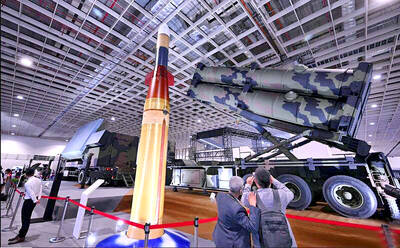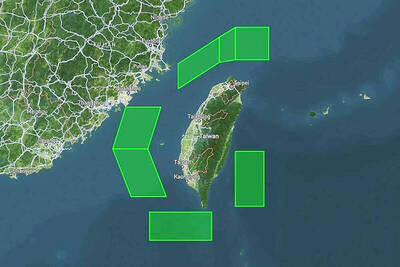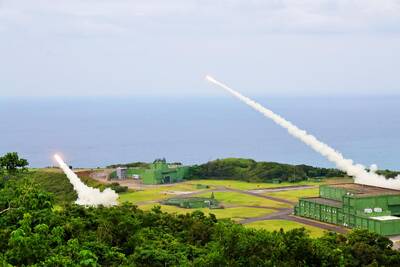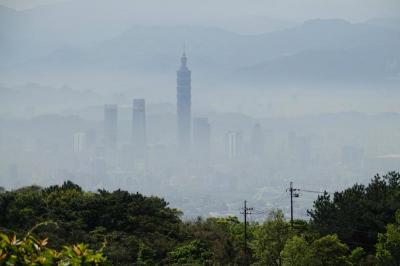President Ma Ying-jeou (馬英九) wants to change the common practice in Taiwan of calling the other side of the Taiwan Strait “China” in favor of the term “the mainland,” Chinese Nationalist Party (KMT) Legislator Hsieh Kuo-liang (謝國樑) said yesterday.
Hsieh, the secretary-general of the KMT caucus, said Ma made the suggestion at a tea party with leading government and legislative officials yesterday.
Hsieh quoted Ma as saying that under the principle of “one China, with each side having its own interpretation” — the so-called “1992 consensus” which the KMT believes was reached during cross-strait talks in Hong Kong in 1992 — Taiwan should not refer to China by its name, but should instead call it “the mainland” or simply “the other side.”
The KMT defines the “1992 consensus” as an agreement according to which it interprets “one China” as the Republic of China (ROC) on Taiwan, while Beijing defines it as the People’s Republic of China (PRC).
The ROC was founded in 1912 in China, but relocated to Taiwan in 1949 after losing the Chinese Civil War to the Chinese communists.
The practice in Taiwan of calling the other side of the Strait “China” was started during the Democratic Progressive Party’s (DPP) eight years in power from 2000 to 2008, as part of a policy to emphasize Taiwan’s existence as separate from that of China.
According to Hsieh, Ma asked government officials yesterday to be more cautious when referring to China, either verbally or in written documents.
The DPP says the “1992 consensus” does not exist.
In 2006, then-KMT legislator Su Chi (蘇起) admitted he made up the term in 2000, when he was head of the Mainland Affairs Council, before the KMT handed over power to the DPP. Su said he coined the term to encourage both sides to keep up cross-strait exchanges.
At the closed-door spring tea party at the National Defense University, Ma also urged officials to be “on alert at all times” and to place wealth distribution high on their policy agenda.
Ma addressed a wide range of issues, among them economics, flood control, cross-strait development and public communication.
The government’s task in the coming year is not only to maintain the economic recovery, which was felt by the public last year, but also improve the distribution of wealth, the president said.
The development of cross-strait relations since his inauguration, including 15 agreements signed between Taiwan and China, has been rapid “because the stagnancy of bilateral relations during the previous administration jeopardized the interests of the people of Taiwan,” Ma was quoted as saying.

Taiwan is to commence mass production of the Tien Kung (天弓, “Sky Bow”) III, IV and V missiles by the second quarter of this year if the legislature approves the government’s NT$1.25 trillion (US$39.78 billion) special defense budget, an official said yesterday. Commenting on condition of anonymity, a defense official with knowledge of the matter said that the advanced systems are expected to provide crucial capabilities against ballistic and cruise missiles for the proposed “T-Dome,” an advanced, multi-layered air defense network. The Tien Kung III is an air defense missile with a maximum interception altitude of 35km. The Tien Kung IV and V

The disruption of 941 flights in and out of Taiwan due to China’s large-scale military exercises was no accident, but rather the result of a “quasi-blockade” used to simulate creating the air and sea routes needed for an amphibious landing, a military expert said. The disruptions occurred on Tuesday and lasted about 10 hours as China conducted live-fire drills in the Taiwan Strait. The Civil Aviation Administration (CAA) said the exercises affected 857 international flights and 84 domestic flights, affecting more than 100,000 travelers. Su Tzu-yun (蘇紫雲), a research fellow at the government-sponsored Institute for National Defense and Security Research, said the air

Taiwan lacks effective and cost-efficient armaments to intercept rockets, making the planned “T-Dome” interception system necessary, two experts said on Tuesday. The concerns were raised after China’s military fired two waves of rockets during live-fire drills around Taiwan on Tuesday, part of two-day exercises code-named “Justice Mission 2025.” The first wave involved 17 rockets launched at 9am from Pingtan in China’s Fujian Province, according to Lieutenant General Hsieh Jih-sheng (謝日升) of the Office of the Deputy Chief of the General Staff for Intelligence at the Ministry of National Defense. Those rockets landed 70 nautical miles (129.6km) northeast of Keelung without flying over Taiwan,

A strong continental cold air mass is to bring pollutants to Taiwan from tomorrow, the Ministry of Environment said today, as it issued an “orange” air quality alert for most of the country. All of Taiwan except for Hualien and Taitung counties is to be under an “orange” air quality alert tomorrow, indicating air quality that is unhealthy for sensitive groups. In China, areas from Shandong to Shanghai have been enveloped in haze since Saturday, the ministry said in a news release. Yesterday, hourly concentrations of PM2.5 in these areas ranged from 65 to 160 micrograms per cubic meter (mg/m³), and pollutants were